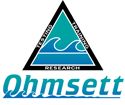The Minerals Management Service (MMS) has funded upgrades to the Ohmsett wave generator to improve the quality of waves with the aim of simulating ocean waves more closely.
While the old wave forms were adequate for testing oil spill response equipment, they were not close enough to ocean waves to satisfactorily evaluate alternative energy devices which are now being tested at Ohmsett.
The objective is to enhance existing wave generator capabilities to produce wave spectra (frequency and amplitude) by varying stroke acceleration and speed instantaneously. This effort includes retrofitting the existing wave generator system with dual action hydraulic actuators to drive wave flaps, programming the computer to create wave spectra and, in the future, upgrading the existing beaches.
The wave flap frequency and amplitude can be varied on each stroke by following a computer-generated, random wave spectrum that more closely approximate waves in the ocean. The new system can produce waves as high as one metre, simulated harbor chop, FM Slides, JONSWAP, and Pierson-Moskowitz spectra with the controlling parameters wind, velocity and scale ratio.
Plans for new beach systems
At Ohmsett, reflected waves are controlled by a system of ‘beaches’ at the end of the test tank, opposite the wave flap. The beach system extends from the test tank floor to the calm water line. When waves are generated at one end of the tank, a portion of the wave that impacts the beach is partially damped while the portion of the wave above the water line is not affected by the beach. This results in a reflective wave traveling back towards the wave flap with the potential to cancel incoming waves or amplify them, depending on the resonance of wave frequencies.
A new wave-damping beach system, which will attenuate the reflected waves so that they don’t interfere with newly generated waves, is planned for the upcoming year. Along with the recent wave flap improvements, a more effective beach system will be installed, allowing Ohmsett to generate realistic waves that can be used by researchers testing the performance of hydrodynamic energy converting devices. This three-phase effort will include quantifying reflected wave energy and effectiveness of the present beaches; designing and retrofitting improvements to the existing beaches; and designing, building, and installing a new beach. The improvements are scheduled to be completed by the end of 2010.

